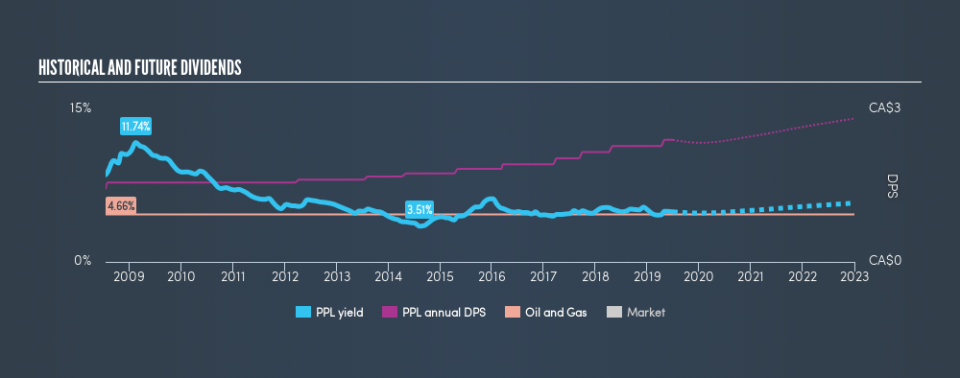Is Pembina Pipeline Corporation (TSE:PPL) A Great Dividend Stock?

Want to participate in a short research study? Help shape the future of investing tools and you could win a $250 gift card!
Dividend paying stocks like Pembina Pipeline Corporation (TSE:PPL) tend to be popular with investors, and for good reason - some research suggests a significant amount of all stock market returns come from reinvested dividends. Yet sometimes, investors buy a stock for its dividend and lose money because the share price falls by more than they earned in dividend payments.
With Pembina Pipeline yielding 4.9% and having paid a dividend for over 10 years, many investors likely find the company quite interesting. It would not be a surprise to discover that many investors buy it for the dividends. Some simple analysis can offer a lot of insights when buying a company for its dividend, and we'll go through this below.
Click the interactive chart for our full dividend analysis
Payout ratios
Dividends are typically paid from company earnings. If a company pays more in dividends than it earned, then the dividend might become unsustainable - hardly an ideal situation. Comparing dividend payments to a company's net profit after tax is a simple way of reality-checking whether a dividend is sustainable. In the last year, Pembina Pipeline paid out 101% of its profit as dividends. Unless there are extenuating circumstances, from the perspective of an investor who hopes to own the company for many years, a payout ratio of above 100% is definitely a concern.
We also measure dividends paid against a company's levered free cash flow, to see if enough cash was generated to cover the dividend. Pembina Pipeline paid out 117% of its free cash flow last year, which we think is concerning if cash flows do not improve. Cash is slightly more important than profit from a dividend perspective, but given Pembina Pipeline's payouts were not well covered by either earnings or cash flow, we would definitely be concerned about the sustainability of this dividend.
Is Pembina Pipeline's Balance Sheet Risky?
As Pembina Pipeline has a meaningful amount of debt, we need to check its balance sheet to see if the company might have debt risks. A rough way to check this is with these two simple ratios: a) net debt divided by EBITDA (earnings before interest, tax, depreciation and amortisation), and b) net interest cover. Net debt to EBITDA is a measure of a company's total debt. Net interest cover measures the ability to meet interest payments. Essentially we check that a) the company does not have too much debt, and b) that it can afford to pay the interest. With net debt of 3.62 times its EBITDA, investors are starting to take on a meaningful amount of risk, should the business enter a downturn.
We calculated its interest cover by measuring its earnings before interest and tax (EBIT), and dividing this by the company's net interest expense. Pembina Pipeline has EBIT of 5.68 times its interest expense, which we think is adequate.
Consider getting our latest analysis on Pembina Pipeline's financial position here.
Dividend Volatility
From the perspective of an income investor who wants to earn dividends for many years, there is not much point buying a stock if its dividend is regularly cut or is not reliable. For the purpose of this article, we only scrutinise the last decade of Pembina Pipeline's dividend payments. During the past ten-year period, the first annual payment was CA$1.44 in 2009, compared to CA$2.40 last year. This works out to be a compound annual growth rate (CAGR) of approximately 5.2% a year over that time.
Companies like this, growing their dividend at a decent rate, can be very valuable over the long term, if the rate of growth can be maintained.
Dividend Growth Potential
Examining whether the dividend is affordable and stable is important. However, it's also important to assess if earnings per share (EPS) are growing. Growing EPS can help maintain or increase the purchasing power of the dividend over the long run. Strong earnings per share (EPS) growth might encourage our interest in the company despite fluctuating dividends, which is why it's great to see Pembina Pipeline has grown its earnings per share at 15% per annum over the past five years. Although earnings per share are up nicely Pembina Pipeline is paying out 101% of its earnings as dividends, which we feel is borderline unsustainable without extenuating circumstances.
Conclusion
When we look at a dividend stock, we need to form a judgement on whether the dividend will grow, if the company is able to maintain it in a wide range of economic circumstances, and if the dividend payout is sustainable. We're a bit uncomfortable with Pembina Pipeline paying out a high percentage of both its cashflow and earnings. That said, we were glad to see it growing earnings and paying a fairly consistent dividend. While we're not hugely bearish on it, overall we think there are potentially better dividend stocks than Pembina Pipeline out there.
Companies that are growing earnings tend to be the best dividend stocks over the long term. See what the 11 analysts we track are forecasting for Pembina Pipeline for free with public analyst estimates for the company.
If you are a dividend investor, you might also want to look at our curated list of dividend stocks yielding above 3%.
We aim to bring you long-term focused research analysis driven by fundamental data. Note that our analysis may not factor in the latest price-sensitive company announcements or qualitative material.
If you spot an error that warrants correction, please contact the editor at editorial-team@simplywallst.com. This article by Simply Wall St is general in nature. It does not constitute a recommendation to buy or sell any stock, and does not take account of your objectives, or your financial situation. Simply Wall St has no position in the stocks mentioned. Thank you for reading.

 Yahoo Finance
Yahoo Finance 
